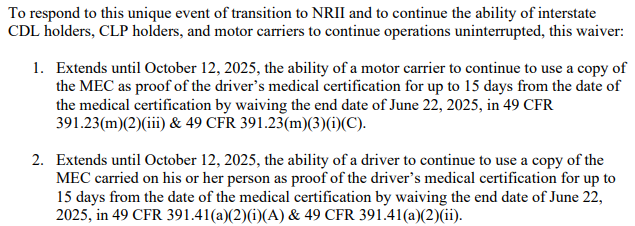New Trucking Rules That Already Took Effect in 2025

If you’re behind the wheel or managing a fleet, you already know that trucking regulations never stay still. This year is no exception. The new trucking rules in 2025 bring changes that could make your job easier or more complicated, depending on how ready you are.
We’ve broken down the most important updates so you know exactly what’s changing and what to do next. No fluff, just the facts that matter.
English Skills Are a Must for Truckers
Starting March 1, 2025, truck drivers will need to demonstrate the ability to read traffic signs and communicate effectively in English. This includes communication with traffic safety officers, border patrol agents, agricultural checkpoints, and cargo weight station personnel.

This rule also applies to following directions from customers or employers and giving updates when needed. While this may feel like extra pressure for drivers who speak English as a second language, it’s really about safety and smooth communication on the road.
If this applies to you or your team, now’s the time to look into language classes or practice resources. Being able to clearly explain issues, follow instructions, and understand signage will help avoid misunderstandings, delays, or even fines.
MC Numbers Are Going Away
October 1, 2025, marks the end of MC (Motor Carrier) numbers. Moving forward, the FMCSA will only use USDOT numbers, adding suffixes to distinguish the type of authority granted.
For trucking companies and fleet managers, this simplifies things. One identifier, one system. But don’t wait to update your records. You’ll need to revise your internal databases, software, and documents well before the change kicks in.
You May Also Like: The Difference Between DOT Number and MC Number
“FMCSA has proposed no longer assigning MC Numbers… the USDOT Number would become the sole identifier for all FMCSA registrants.” — FMCSA Registration Modernization FAQs.
With the current administration leaning toward deregulation, the next few years could bring even more changes. Stay informed by keeping up with FMCSA updates, engaging in public comment periods, and tracking regulatory shifts that affect your fleet.
No More Paper Medical Cards
Remember those small DOT medical cards you had to carry? They can finally go digital. Starting June 23, 2025, medical examiners are required to submit medical certification information electronically through the National Registry system. This means drivers won’t need to carry the physical card anymore, which is great news for avoiding lost or forgotten paperwork.
This change is a big win because it makes it easier for fleets and regulators to keep track of everyone’s medical status. It also saves drivers the hassle of carrying around a physical card. That said, some states and medical examiners are still getting used to the new system, so don’t be surprised if there are a few bumps along the way before the full switch happens on October 12, 2025.
And here’s something important: if your medical certification is valid, you and your employer shouldn’t get penalized for any delays caused by this system transition. It’s only fair since the paperwork side is still catching up.
You May Also Like: How Truck Drivers Can Renew Their DOT Medical Card in 2025

Rest Rules Are Getting More Flexible
This is one of the more exciting changes. FMCSA introduced pilot programs that let drivers split their sleeper berth time into smaller chunks. So instead of one long 10-hour rest, you could take a 6-hour break and then a 4-hour break later. There is also a split-duty pilot that lets you pause your duty clock for short rest breaks.
For drivers who struggle to get a full, long rest in one go, this can be a game-changer. It makes rest schedules more realistic and potentially safer. But here is the catch. These new rules make logging your hours more complicated. You have to be extra careful to track everything right. Otherwise, you risk violations.
The pilot programs began in 2024 and will continue through 2025 as FMCSA evaluates them. Keep an eye on official updates to see if and when they become permanent.
You May Also Like: What's New in FMCSA Hours of Service Regulations for 2025?

Replace Revoked ELD Devices Immediately
In 2025, the FMCSA revoked eight electronic logging devices that no longer met technical standards. The decision took effect on May 12, 2025, with a 60-day grace period to replace the non-compliant ELDs.
You May Also Like: What Are DOT Logbook Requirements for Truckers in 2025?

The deadline to replace revoked ELDs was July 11, 2025. If any driver is still using a revoked ELD can be placed out of service for lack of a valid electronic log. If you have not done so already, replace any revoked devices immediately to avoid downtime and penalties.
Speed Limiter Rule Update
Earlier this year, FMCSA was expected to roll out a rule mandating speed limiters for heavy trucks, especially those already equipped with electronic control units. The aim was to reduce accident severity and improve highway safety.
But that rule didn’t move forward. The FMCSA paused the proposal and also cleaned up thousands of minor, outdated violations in its records. This streamlining effort is meant to make compliance easier and reduce red tape.
For many fleets, that’s good news. It gives managers more flexibility while still emphasizing safety. That said, fewer regulations shouldn’t mean less caution. Industry experts warn that pulling back too much could make it harder to protect drivers and improve road safety overall.
So even if the speed limiter rule is off the table for now, smart fleets will still keep safety at the center of their operations.
The 2025 trucking rules cover everything from identification numbers to ELD compliance, medical card modernization, and HOS flexibility. These changes reflect both new technology and a shift toward more practical, real-world policies.
But preparation is key. Take time now to update your systems, educate your drivers, and stay informed about FMCSA rule changes that could affect your business.












